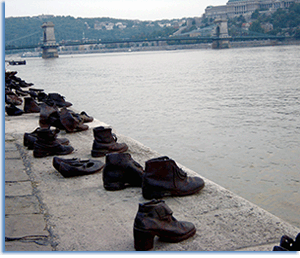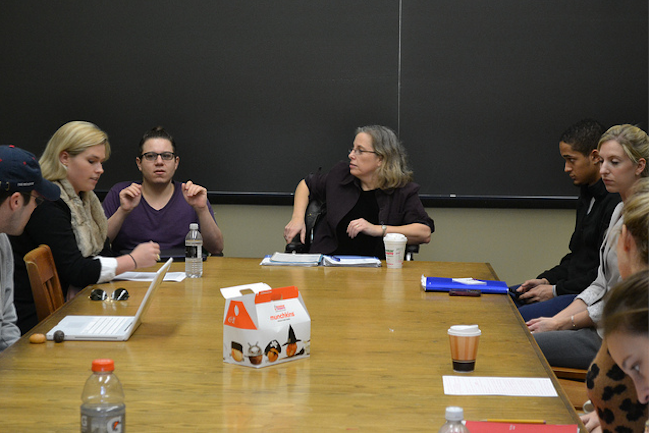History major Alex Stroud ’13 Creates Belt Company in South America
By:Jackie Sanders ’14 for The Trinity Tripod
“In July 2011, Alex Stroud ’13 launched an Argentinean-inspired belt company with his brother that has grown into a multi-accessory high end brand. Stroud’s company, La Matera, is perfect for Trinity students. The belts come in a variety of colors and each one has an individual look. If described in one word, La Matera would be “tribal.” Stroud first found inspiration for his belts when he travelled to Argentina in 2008. After his sophomore year at Trinity, Stroud went back to Argentina to work on a ranch about 18 hours south of Buenos Aires. Alone on the ranch with plenty of time to think, Stroud began to realize he should bring Argentinean style back home. He believed that if he improved the quality and design of belts already sold in Argentina, he could successfully sell them in America where they are not available. Soon after, he proposed this idea to the guachos working on the ranch.
History Students Go On Bird Viewing Cruise

Professor Wickman took his History 300 class on an eagle cruise on the Connecticut River. Since his history workshop theme is, “History from Above: Birds and People in the New World, 1492-1962,” biology professor Scott Smedley invited his class to join his “Winter Ecology” class on the bird viewing cruise. The boat went south from Haddam, CT, and gave them a chance to see bald eagles, red-tailed hawks, cormorants, mergansers, Canada geese, gulls, and many other birds. Hopefully the experience provided inspiration as the students craft research projects related to changing human relationships with birds!
Faculty Honors List Fall Term 2012
 In early February Interim Dean of Faculty Dr. Richard Prigodich sent out a list of undergraduate students who had been awarded Faculty Honors for teh Fall Term, 2012, which included 9 history majors. Congratulations to Kathleen McKenna, Michael Morus, Alex Stroud, Sabra Wilson, William Hering, Harry Lawrence, Maia Madison and Codyann Patrina.
In early February Interim Dean of Faculty Dr. Richard Prigodich sent out a list of undergraduate students who had been awarded Faculty Honors for teh Fall Term, 2012, which included 9 history majors. Congratulations to Kathleen McKenna, Michael Morus, Alex Stroud, Sabra Wilson, William Hering, Harry Lawrence, Maia Madison and Codyann Patrina.
BBC News: The History of the Future in 10 Images
“The BBC’s What If? season explores visions of the future through subjects such as health, war and technology. But how did artists and dreamers from the past imagine the modern world? 1. More police officers – equipped with personal flying machines – was Punch cartoonist Charles Harrison’s vision of the future. His 1901 illustration, strangely titled Increased Activity Of Police: A possibility of the very near future, came with the caption, “Now then, thirty miles an hour won’t do up here! I’ve timed you with my aneroid barometrical check clock and you’ll have to come down to the station!” The officer’s unlucky subjects were speeding in a flying machine – a popular theme explored by future-gazers. 2. Leonardo da Vinci sketched an early design for a helicopter – which he called the Aerial Screw – in the 1480s. Roughly sketched on paper, his diagram includes notes to explain how his flying machine would work. In his annotations he wrote: “I believe that if this mechanism is well made with starched linen cloth and if it is spun rapidly, the screw will… rise up high into the air.” According to The National Museum of Science and Technology in Milan, the screw has a five-metre diameter and is made of reed, linen cloth and wire. His machine was never made, but Da Vinci’s plan was that the shaft would be spun by four men as they stood on the central platform and pushed the bars in front of them with their hands.” (Full Article with Images HERE)
The Mill Faculty Lecture Series at Trinity College
THE MILL PRESENTS: THE MILL FACULTY LECTURE SERIES:
“The Mill is a diverse group of creative students committed to enhancing the social climate at Trinity College. As a group representing the myriad of social niches on campus, we actively seek new opportunities to promote themes of creativity, innovation and passion. The goal is to unify a vibrant and eclectic student body and improve social culture by fostering the student arts. As a venue, theMill enables creative expression, artistic collaboration and innovative thought.” On Jan 29th, Prof John Alcorn delivered the first lecture on the legalization of drugs. Professors Markle and Seidman of the History Dept. are scheduled to give lectures on their research in April. Mark your calendars!
For more information go HERE and The Mill The Blog.
Photos: Prof. Greenberg’s Day in a Wheelchair
On December 5, 2012, Professor Greenberg of the History Department was one of twenty-five members of the Trinity College community who spent “A Day in a Wheelchair”. According to one source: “The aim of this project was to experience what it was like to have a mobility impairment. The idea originated with Kristin Duquette ’13, a human rights major. According to Duquette and Sean Snyder ’13, who is also a human rights major and an organizer of the event, “A Day in a Wheelchair” was designed to be an empowering and positive experience while shattering the stereotype of what it’s like to be wheelchair-bound. The goal was for members of the campus community to become aware of the accessible routes on campus and realize that having a disability doesn’t impair one’s contributions.”
Reflections: “Tragedy, Memory, History”

James Grossman, executive director of the American Historical Association, recently wrote a piece musing on what he called “the vexed relationship between history and memory.” In a visit to Hungary he realized that all the museums and monuments he visited focused on victims rather than perpetrators and began thinking about “the implications of a politics of nationhood that relies on victimization as its central theme.” As he notes, it allows Hungarians to avoid any responsibility for what was done, from participation in the killing of Jews during WWII to collaboration with the Soviets I oppressing their countrymen during the Cold War. He then considers how Americans depict our own history – are we focusing on victimization too, thus avoiding responsibility for evil actions of our past – Prof. Cheryl Greenberg (History Dept.)
(more…)
Meet Team Thesis AY2012/13
 By: Daniel Morgan (History major, Class of 2013)
By: Daniel Morgan (History major, Class of 2013)
Is there anything more quintessential to the education of young historians than the thesis exercise? Writing a two semester thesis has long been a staple of the liberal arts curriculum, and rightly so. Through this labor of love, a history major puts all of his or her skills to the test (from critical and analytical reading to the development of a cogent and articulate argument) and ultimately produces a work which adds to the collective body of Trinity scholarship. The History Department thesis writers for the class of 2013 are (alphabetical by last name): Kyle Loder, Kathleen McKenna, Francis Russo, and Emma Sternloff. This writer is also a thesis writer for the 2013 year – however, I would like to step back after this brief introduction, and let my colleagues speak for themselves. I have asked each of this year’s thesis writers to comment briefly on writing a history thesis, as well as their opinions on history scholarship in general.
(more…)
Into the Archives: CT Historical Society Research Center

By: Emma Sternloff (History major, Class of 2013)
My visit to the Connecticut Historical Society Research Center with Professor Wickman and Francis Russo offered a unique opportunity to connect with my thesis subject. I’m writing about James Hammond Trumbull, a nineteenth-century scholar and the first librarian of the Watkinson Library, and his study of Native American history and language. Trumbull was a polymath, interested in everything from botany to bibliography, but he had a particular passion for Connecticut’s colonial past. Accordingly, he was an enthusiastic member of the Connecticut Historical Society, joining the organization in 1847 and serving as president from 1863 to 1889. Given Trumbull’s long-standing connection to the CHS, I had high hopes for the archives, and I was not disappointed. I came across several Civil War-era letters written to Trumbull in his capacity as Connecticut’s Secretary of State.
(more…)
“Faculty Highlights”: New book by Professor Zayde Antrim
 Routes and Realms: The Power of Place in the Early Islamic World (2012, Oxford University Press) examines early texts produced by Muslims during the ninth through eleventh centuries, paying specific attention to how the authors conveyed attachment to the lands in which they lived. This attachment created what Antrim describes as “widely resonant categories of belonging. “Representing plots of land as homes, cities, and regions in texts…was a powerful way to claim loyalty, authority, and belonging in the early Islamic world,” said Antrim, who teaches courses on Islamic civilizations, Middle Eastern history, nationalism, and geography. “I have always been interested in geography and the ways in which the geographical imagination shapes the way we see and act in the world.””
Routes and Realms: The Power of Place in the Early Islamic World (2012, Oxford University Press) examines early texts produced by Muslims during the ninth through eleventh centuries, paying specific attention to how the authors conveyed attachment to the lands in which they lived. This attachment created what Antrim describes as “widely resonant categories of belonging. “Representing plots of land as homes, cities, and regions in texts…was a powerful way to claim loyalty, authority, and belonging in the early Islamic world,” said Antrim, who teaches courses on Islamic civilizations, Middle Eastern history, nationalism, and geography. “I have always been interested in geography and the ways in which the geographical imagination shapes the way we see and act in the world.””
Read entire article HERE.



